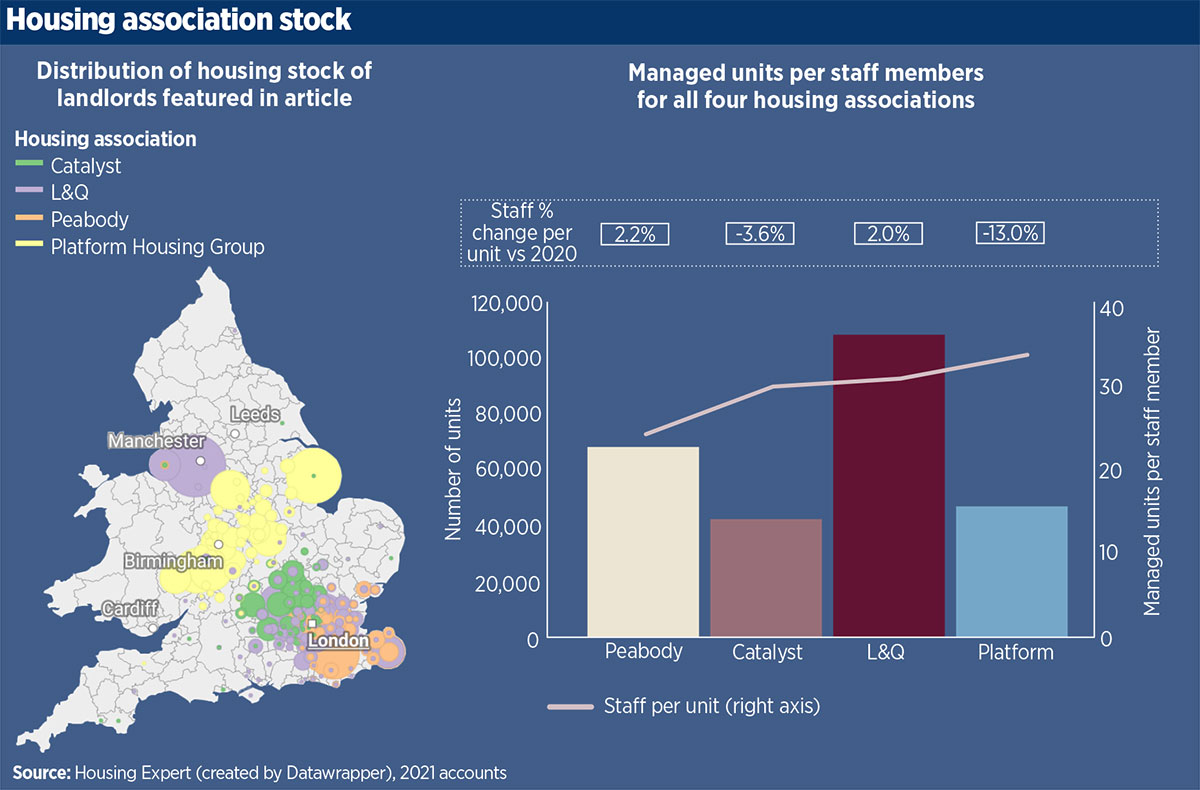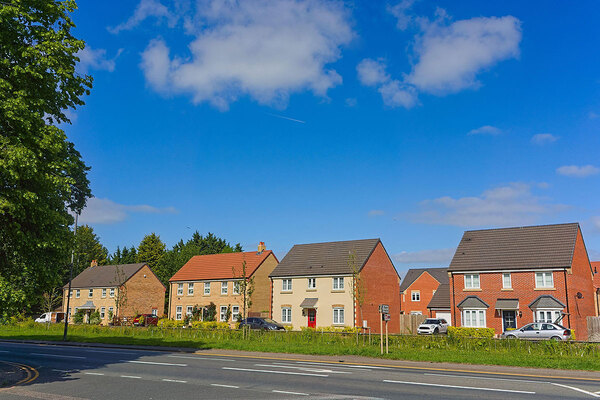The rise of ‘localities’ planning by large HAs
In the face of heightened scrutiny, more housing associations are advocating a ‘localities-based’ approach. James Twomey reports
Last summer, as an ITV News investigation into the conditions that social housing tenants across the UK were living in aired, talk of a changing tide in tenant and landlord relations was catalysed.
Weeks after his appointment as the new housing secretary in September, Michael Gove said that social housing conditions in some parts of the country were “scandalously poor”.
Meanwhile, Justin Welby, the Archbishop of Canterbury, said the issues highlighted in the investigation – such as disrepair, and severe damp and mould – had been “going on for 30 or 40 years”.
One of the highest-profile cases featured Clarion Housing Group, the UK’s largest association at nearly 128,000 homes, with issues identified in some homes at the Eastfields Estate in Mitcham, south London, prompting criticisms that it had outgrown its capacity to adequately provide tenants with the support and communication they needed.
At the time, the Ministry of Housing, Communities and Local Government said that “conditions in the homes highlighted in this case were appalling” and that it had made it “clear this is unacceptable”.
Clarion apologised for past mistakes and acknowledged that it had fallen short of the standards it expects for tenants. More recently, speaking at a Levelling Up, Housing and Communities (LUHC) Committee meeting in January 2022, Clarion’s chief executive Clare Miller said she was “ashamed” of Clarion’s conduct.
The English Housing Survey, published by the Department for Levelling Up, Housing and Communities in December 2021, found that in 2020, 13 per cent of dwellings in the social rented sector failed to meet the Decent Homes Standard.
This figure is lower than the proportion of private rented homes, at 21 per cent, and owner-occupied homes, at 16 per cent.
At the same time, the Regulator of Social Housing has urged registered providers to step up on their landlord services in advance of the incoming consumer regulation regime arising from November 2020’s Social Housing White Paper.
As housing associations consider the task of how best to focus on the needs of tenants, one particular strategy – a ‘localities-driven’ approach – is gaining traction.
Peabody
London’s largest and oldest housing association, Peabody, is in the midst of a merger with fellow London-based social landlord Catalyst.
Expected to be completed this spring, the merger will increase its number of homes from 66,000 to more than 100,000.
Speaking to Social Housing, Ian McDermott, former chief executive at Catalyst, who will be Peabody’s new CEO following the merger, says that its localities plan would be taken from what he believes was a successful example at Catalyst.
Mr McDermott says: “We can evidence the fact that [Peabody’s localities plan] predates [negative media coverage] and this is not a knee-jerk response to bad PR.
“This is a well thought out, carefully planned model that we effectively piloted at Catalyst and introduced to the new organisation as a whole.
Catalyst’s current chief executive, Sarah Thomas, is soon to be chief operating officer at Peabody.
Ms Thomas says: “It’s about having people who can make decisions very quickly and can respond to customer need, and have that autonomy within the organisation, but also [be] held to account within the organisation.
“That is the concept and it’s one that we’ve introduced at Catalyst already, and we want to use that as the blueprint to create a model that will sustain a focus on customers, despite the organisation growing larger, and then benefit from the other benefits of a large organisation.
“For example, at the smallest level, there is one person, one named person, that manages an area.
“From a customer point, let’s take the customers at Catalyst who will be joining into this bigger Peabody organisation – at the moment, they have a named neighbourhood customer specialist and that person won’t change.”
Despite the increased number of homes that Peabody will manage, Mr McDermott says it would not go on a hiring spree to meet the new demand.
He says: “I was previously chief operating officer at Sanctuary several jobs ago and that grew from around 50,000 to 100,000 homes.
“The one thing that you learn is [that] what you can’t do is simply supercharge the structure that you have when you are a small organisation. As you get bigger and bigger, you have to rethink how you’re going to organise yourself to break it down into manageable accountable subsets.
“If you break it down, if you can get that decision-making working locally, then actually you can have a much more functional model but still enjoy some of the benefits of the purchasing power of the infrastructure you get from a big organisation.”
Peabody scored 67 per cent on customer satisfaction in its 2021 annual report, down from 74 per cent the year before, while the G15 average for 2019-20 was 79 per cent.
In 2020-21, Peabody said it completed 190,000 repair jobs and for those repairs achieved 85 per cent customer satisfaction.
“This is a carefully planned model that we effectively piloted at Catalyst and introduced to the new organisation as a whole”
The new Peabody chiefs add that it was in fact Catalyst’s localities plan that made it such an attractive partner to fit into Peabody’s organisation.
Mr McDermott says: “What we discovered was that Peabody were ahead in some areas – in their infrastructure, in their IT, in their portal.
“At Catalyst, we were developing this localities model and that was very attractive to Peabody as a way of breaking the organisation down.
“This merger is not about expanding what we do in terms of development, but it is in terms of protecting what we do at the moment, and the resilience that goes with that.
“I think we both felt the world of housing is changing and that we needed to be one step ahead, and we needed a kind of research and development function, which perhaps we would have struggled to have on our own.
“It’s partly about shared values, partly about shared ambition, and partly protecting what we have already.”
Mr McDermott says he expects Catalyst to have fully integrated into Peabody’s organisation within a year.
It follows a period of merger activity for both Catalyst and Peabody, with the latter having only just finished integrating 9,500-home Town & Country Housing, hot on the heels of a merger with Family Mosaic in 2018.
On that, Mr McDermott says: “My experience of things is that the perfect opportunity rarely comes along at the perfect time.
“I think our initial reaction when we started talking was ‘maybe this is a bit too soon after the last one’.
“But actually, when you started to look at it in the cold light of day, it was very clear that the opportunities it offered simply wouldn’t be available elsewhere.”
Mr McDermott and Ms Thomas say they were confident the merger would not duly impact Peabody’s governance, viability, or credit ratings, and they would not be complacent about ratings from either the regulator or credit ratings agencies.
“We have to work hard to earn [good ratings] at Peabody and the new organisation would have to do the same,” says Mr McDermott.
“We think this makes a stronger organisation and we think we can get the benefits of the localities model and the benefits of scale that the new one operates.
“It should make us stronger and the ratings agencies have stated explicitly that they don’t see the merger as changing our rating.”
Ms Thomas adds that the reason for the merger to be structured the way it was – with Mr McDermott joining Peabody in October 2021 and Ms Thomas moving up to chief executive of Catalyst – was to run Catalyst as an independent organisation up until the point of merger to protect its compliance and performance.
Ms Thomas says: “Catalyst as an independent organisation will achieve all of its year-end goals at the point of merger. This puts us in a really strong position because you’ve got a strong organisation merging with a strong organisation and we’ve already got a very strong integration programme as well to make sure that as those two organisations come together, nothing falls through the gaps.”
L&Q
L&Q, which manages more than 107,000 homes, primarily in London and the South East, featured in ITV’s coverage of poor housing conditions.
In its annual report for 2020-21, the group said it scored 71 per cent in its customer satisfaction rating, while securing a surplus of £208m and a net debt of £5.3bn.
Gerri Scott, its group customer service director, says it had implemented a new localities plan to prevent such instances from occurring again.
Ms Scott says: “We’re going back to quite a basic housing management model. I don’t mean basic as in poor, but basic as in uncomplicated.
“The reasons why we’ve done that is that the way in which we were structured was quite confusing for our residents and it was also quite confusing for our staff.
“We felt that going back to a more traditional structure would give staff the space and time to be able to act better as advocates for residents to get things done.
“But it is a model that we think makes absolute sense to us at this precise moment in time. It has been no secret that we’ve had some quite high-profile cases in the media and that really kind of precipitated a different conversation about how do you want to structure and how do we want to deliver services to residents in the future?”
“Going back to a more traditional structure would give staff the space and time to act better as advocates for residents to get things done”
Ms Scott says L&Q’s new localities system will give neighbourhood housing leads small patches of 550 properties, which is fewer than they were allocated previously, and aligns the leads with local authorities the patches are in.
“Our residents don’t feel necessarily that they’re an L&Q resident but that they live in Lambeth or they live in Slough, or they live in Manchester, and that’s why we want to get something that makes a lot more sense to them, too,” says Ms Scott.
“We absolutely recognise that one size doesn’t fit all, so when we talk about an average size and patch of 550 properties, that will depend on the nature of the development, or the density of the housing, but certainly in London, we think that patch size makes absolute sense.”
L&Q is set to invest £1.5m in additional frontline staffing resources, which will see an additional 60 frontline staff
brought in.
“When we were looking at the reason why things had happened, a part of it was that staff were spread too thinly,” says Ms Scott.
“But I think as an organisation we had to recognise that we needed to make more investment to be able to make that happen.”
Platform
Platform Housing Group, which manages more than 46,000 homes across a large swathe of the Midlands, has also adopted a new localities strategy.
The landlord says it had an 85 per cent customer satisfaction rating on repairs and has secured £250m of grant from Homes England to develop 4,680 homes as part of the Affordable Homes Programme.
With a wider variety of stock than Peabody or L&Q, Platform has split its localities plan into three areas – city, inner city and rural – with a focus on data collection to help tenants.
“Every interaction we have with a customer, we offer and collect as much data to support them with any issues they have”
Marion Duffy, chief operating officer at Platform, says: “We have our frontline colleagues in our housing office and our own community engagement teams that are out visiting customers, and what we’ve designed through our localities is what we call ‘tenancy health checks’.
“Every interaction we have with a customer, we offer and collect as much data to support them with any issues they have.
“Through that we can establish things that they probably wouldn’t have told us before.
“A customer will be asked if they have any ongoing issues that haven’t been resolved with Platform. Are they managing to pay their rent? Are there any safeguarding issues? How are they going to cope with the increased fuel and energy prices? We go through a checklist.
“We’ll look for any updates in their family make-up in their tenancy, so that we can update our data and we know who lives in our homes and how we can tailor services to them.”
At the LUHC committee in January 2021, there was consensus that in the absence of sufficient government grant, housing associations would be forced to expand in order to meet the demands of new housing.
An effective localities plan for these mega-landlords may be the way to mitigate against poor housing conditions and complaints falling through the cracks.
Sign up for the Social Housing Finance Conference
The leading one-day event for senior finance and treasury professionals
Brought to you by Social Housing magazine, the Social Housing Finance Conference (11 May, etc. venues, St Paul’s, London) is recognised as the longest-standing, leading one-day event bringing together sector leaders and senior finance and treasury professionals from across the sector to discuss the strategic, operational and technical finance matters of most importance.
RELATED









